« Dive trip to Honduras! | Main | Prince Albert and green blood »
August 24, 2008
First ocean dive
I've had my first ocean dive. It was actually three, an orientation dive in the morning and then two boat dives in the afternoon.
Apparently, no matter what age I am, I get uptight whenever I do something new for the first time. I fell asleep just fine the evening before the dive, and had a good night's sleep, but during breakfast and then the orientation upstairs in the clubhouse I was absurdly nervous. Just like I used to get when I had to give a speech.
We then got geared up and entered the very shallow water at the beach in front of CoCo View's clubhouse. Our divemaster, Melgar, gave an introduction: first we'd swim down an incline, then congregate at the anchor plate of the buoy to demonstrate skills (flooding and clearing the mask; removing the regulator and blowing bubbles), then go past the wreck of the Prince Albert and on to Newman's Wall, then back to the wreck and over to the other side where CoCo View Wall is. That sounded like an awful lot of distance for just an orientation dive, and it felt like it, too, but when it was all over it had taken all of 45 minutes.
I had often wondered what it'd be like to see a shipwreck underwater. I envisioned it as spooky and threatening, sort of the ultimate symbol of human maritime defeat. A ship sinks and goes down to the bottom of the ocean. The image of the water closing over it and it falling has always felt extremely ominous to me.
But seeing the Prince Albert, a 140 foot long hulking former tanker, was not that threatening. Maybe it was the good visibility, or maybe shipwrecks are just one of those things that looks and feels all different once you actually see one underwater. We did not stay and peruse the encrusted wreck of the ship that'd been sunk as a diving attraction in 1985. There'd be plenty of time for that later.
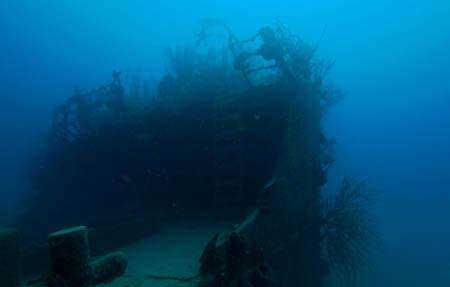
Close to the wreck we saw a school of squid slowly circling in formation. An amazing sight that was. They have those huge eyes and you never quite know which side is the front and which the back. They seem intelligent, very deliberate, and very different from fish that tend to dart around this way and that.
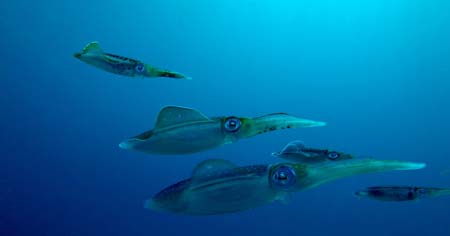
The Newman wall was imposing, and I assume representative for a lot of Caribbean underwater walls. It's far steeper and rockier down there than you'd expect judging by the looks of the geography above the water. Roatan is hilly, for sure, but it does not seem to have the sheer cliffs that drop down many hundreds or thousands of feet. And every square inch underwater is occupied by something -- plants, fish, sea critters of all kinds. This is really what blew me away most. Lake Tahoe has awesome scenery and walls, but it is nearly devoid of life. Here I saw nothing but life teeming all over the place.
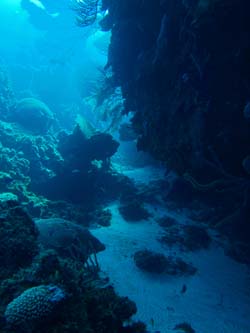 I still wrestled with some irrational fears, most of which I attribute to my initial uneasiness with new things. I am aware at all times, for example, of having all that water above me. If anything goes wrong there is simply no margin for error. What would happen if I had a sudden bout of ... something? Would I be able to handle it? Also, I do like to see what's around me, and I get uneasy when the visibility is bad and things go blank. When you dive you don't fall. Gravity as we know it is suspended. But the brain doesn't know that. So it can feel weird to float in nothingness, or turn around and see nothing but open water. But it is not only space; temperature fluctuations can also sneak up on you. You feel your body go cold and for an anxious few seconds wonder if something's wrong. Then you remember: thermocline. I don't mind cold water, but the sudden changes can make me uneasy. That was certainly not a problem in Roatan as the water temperature was 86 degrees and it never got below 84 even at the bottom. Not having to deal with cold water and thermoclines felt good.
I still wrestled with some irrational fears, most of which I attribute to my initial uneasiness with new things. I am aware at all times, for example, of having all that water above me. If anything goes wrong there is simply no margin for error. What would happen if I had a sudden bout of ... something? Would I be able to handle it? Also, I do like to see what's around me, and I get uneasy when the visibility is bad and things go blank. When you dive you don't fall. Gravity as we know it is suspended. But the brain doesn't know that. So it can feel weird to float in nothingness, or turn around and see nothing but open water. But it is not only space; temperature fluctuations can also sneak up on you. You feel your body go cold and for an anxious few seconds wonder if something's wrong. Then you remember: thermocline. I don't mind cold water, but the sudden changes can make me uneasy. That was certainly not a problem in Roatan as the water temperature was 86 degrees and it never got below 84 even at the bottom. Not having to deal with cold water and thermoclines felt good.
Carol had told me many times that managing one's buoyancy in saltwater was much easier than in fresh water. I took her word for it, but it was hard for me to imagine that salt and whatever else is dissolved in ocean water would make that much of a difference. The specific weight between salt and sweet water is very close. However, as I quickly found out, it DOES make a HUGE difference.
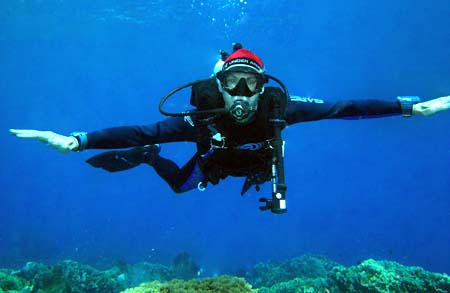
In fresh water, where all of my previous dives had taken place (with the exception of that saltwater pool, but that doesn't count), buoyancy is a constant struggle. It is quite hard to consistently stay off the bottom so as not to stir up silt. In seawater, if you have your weights right, that is simply not an issue. I just floated, glided, hovered, flew, without any problem at all. It felt like magic. And it's a good thing, too, because the plantlife on the reefs is far more fragile than I imagined and I sure did not want to harm it.
Diving a reef, I found, is like slowly flying over and through a Pixar landscape. It's like being in "A Bug's Life" or "Finding Nemo," only much more intense and, of course, real. Those guys at Pixar must be divers, I am sure. The diversity and vitality of all those plants is simply amazing: all sorts of sponges and gorgonians (seafans) are everywhere. Some cover rocks, some bulge out, some stick out weightlessly. There's a myriad of different kinds of coral. Fish dart in and out between them in a never-ending fluid dance. Some are lightning quick, some deliberate. The water is a very different medium to live and move around in.
After lunch I experienced my first ocean boat dive. We were on the green boat, the CoCo III. The boats are larger than the ones I'd been on on the Manatee snorkel tours, and the cutout in the center through with you can get back into the boat by climbing up a ladder is fairly unique. Divers sit along the sides by their gear.
The first actual dive site we visited was called "Too Tall Too Small." I am not sure where it got that name. My guess is the resorts get quite creative naming those sites as there are so many. It was a marvelous wall dive, again full of teeming life of all sorts. As I was gliding through this wonder world I thought of the Beatles song "Lucy in the Sky with Diamonds" where they sing of "cellophane flowers of yellow and green," and "newspaper taxis waiting to take you away" and similar. Some said that song was really about acid trips (Lucy in the Sky with Diamonds), but though I have no firsthand experience I cannot imagine an acid or any other drug-induced trip to be any wilder than diving a reef.
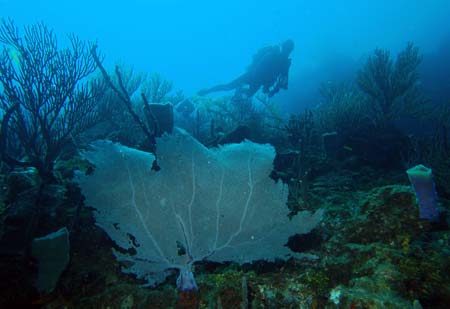
The combination of weightlessly floating amidst this unreal, unbelievable underwater world with colors and shapes I'd never seen; hearing myself breathing air from a tank on my back; knowing that I was deep under the surface and really in quite a fragile position, it all adds up to a suspense of reality as we know it on the surface. It makes you think and question things. There's so much down there, and it's all so different from the familiar dry world above. The ocean is huge and endless but also delicate and tender. A single boat anchor carelessly dragged across the reefs can destroy what took decades or hundreds of years to build, and what is home to an intricate miraculous world that is a miracle.
Posted by conradb212 at August 24, 2008 11:50 PM








